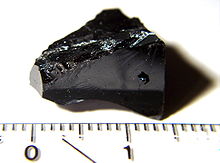
Back Kadmiumtelluried Afrikaans تيلوريد الكادميوم Arabic کادمیوم تلورید AZB Tel·lurur de cadmi Catalan Cadmiumtellurid German Τελλουριούχο κάδμιο Greek Kadmia telurido Esperanto Telururo de cadmio Spanish کادمیم تلورید Persian Tellurure de cadmium French

| |

| |
| Names | |
|---|---|
| Other names
Irtran-6
| |
| Identifiers | |
3D model (JSmol)
|
|
| ChemSpider | |
| ECHA InfoCard | 100.013.773 |
| EC Number |
|
PubChem CID
|
|
| RTECS number |
|
| UNII | |
CompTox Dashboard (EPA)
|
|
| |
| |
| Properties | |
| CdTe | |
| Molar mass | 240.01 g/mol |
| Density | 5.85 g·cm−3[1] |
| Melting point | 1,041 °C (1,906 °F; 1,314 K)[2] |
| Boiling point | 1,050 °C (1,920 °F; 1,320 K) |
| insoluble | |
| Solubility in other solvents | insoluble |
| Band gap | 1.5 eV (@300 K, direct) |
| Thermal conductivity | 6.2 W·m/m2·K at 293 K |
Refractive index (nD)
|
2.67 (@10 μm) |
| Structure | |
| Zinc blende | |
| F43m | |
a = 0.648 nm
| |
| Thermochemistry | |
Heat capacity (C)
|
210 J/kg·K at 293 K |
| Hazards | |
| GHS labelling: | |
 
| |
| Warning | |
| H302, H312, H332, H410, H411 | |
| P261, P264, P270, P271, P273, P280, P301+P312, P302+P352, P304+P312, P304+P340, P312, P322, P330, P363, P391, P501 | |
| NIOSH (US health exposure limits): | |
PEL (Permissible)
|
[1910.1027] TWA 0.005 mg/m3 (as Cd)[3] |
REL (Recommended)
|
Ca[3] |
IDLH (Immediate danger)
|
Ca [9 mg/m3 (as Cd)][3] |
| Related compounds | |
Other anions
|
Cadmium oxide Cadmium sulfide Cadmium selenide |
Other cations
|
Zinc telluride Mercury telluride |
Except where otherwise noted, data are given for materials in their standard state (at 25 °C [77 °F], 100 kPa).
| |
Cadmium telluride (CdTe) is a stable crystalline compound formed from cadmium and tellurium. It is mainly used as the semiconducting material in cadmium telluride photovoltaics and an infrared optical window. It is usually sandwiched with cadmium sulfide to form a p–n junction solar PV cell.
- ^ Peter Capper (1994). Properties of Narrow Gap Cadmium-Based Compounds. IET. pp. 39–. ISBN 978-0-85296-880-2. Retrieved 1 June 2012.
- ^ "Nomination of Cadmium Telluride to the National Toxicology Program" (PDF). United States Department of Health and Human Services. Retrieved 11 April 2003.
- ^ a b c NIOSH Pocket Guide to Chemical Hazards. "#0087". National Institute for Occupational Safety and Health (NIOSH).